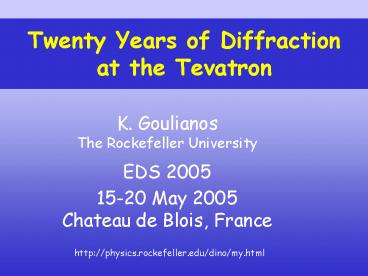Twenty Years of Diffraction at the Tevatron - PowerPoint PPT Presentation
Title:
Twenty Years of Diffraction at the Tevatron
Description:
1990's Tev Run-I: Regge factorization breakdown. Tev vs HERA: QCD ... Twenty Years of Diffraction at the Tevatron K. Goulianos. 7. CDF Run 1-0 (1988-89) ... – PowerPoint PPT presentation
Number of Views:57
Avg rating:3.0/5.0
Title: Twenty Years of Diffraction at the Tevatron
1
Twenty Years of Diffractionat the Tevatron
K. Goulianos The Rockefeller University EDS
2005 15-20 May 2005 Chateau de Blois, France
http//physics.rockefeller.edu/dino/my.html
2
-p Interactions
Diffractive vacuum exchange
Non-diffractive color exchange
Protons retain their quantum numbers
Protons acquire color and break apart
3
Why StudyParticle Diffraction?
4
Asymmetric Fireworks?
5
Non-perturbative QCD
- Important for understanding hadron structure
and quark confinement - Need to develop new mathematical methods
- Diffraction offers an arena on which to
confront non-pQCD
pure thinking!
THEORY
phenomenology
experiment
6
Forty Years of DiffractionTwenty Years at the
Tevatron
- 1960s BNL first observation of pp -gt pX
- 1970s Fermilab fixed target, ISR, SPS
- ? Regge theory factorization
- Review KG, Phys. Rep.
101 (1983) 169 - 1980s UA8 diffractive dijets a hard
diffraction - 1990s Tev Run-I Regge factorization
breakdown - Tev vs HERA QCD factorization breakdown
- 21st C Multigap diffraction
restoration of factorization - Ideal for diffractive studies _at_ LHC
7
CDF Run 1-0 (1988-89)
Elastic, single diffractive, and total cross
sections
_at_ 546 and 1800 GeV
Roman Pot Spectrometers
- Roman Pot Detectors
- Scintillation trigger counters
- Wire chamber
- Double-sided silicon strip detector
Additional Detectors Trackers up to h 7
- Results
- Total cross section stot se
- Elastic cross section ds/dt exp2a
lns ? shrinking forward peak - Single diffraction Breakdown of Regge
factorization
8
Run 1-0 results in perspective
9
CDF Run 1 (1992-1995)
10
Diffraction _at_ CDF in Run I
93(2004)141601
11
Diffractive Fractions _at_ CDF
All ratios 1 ? uniform suppression
FACTORIZATION
Fraction SD/ND ratio at 1800 GeV
12
Tevatron vs HERABreakdown of QCD Factorization
H1
CDF
13
Multigap Diffraction
(KG, hep-ph/0205141)
f
y
14
Elastic and Total Cross Sections
QCD expectations
15
Single Diffraction
sub-energy x-section
gap probability
Gap probability MUST be normalized to unity!
16
Single diffraction (re)normalized
17
Total Single Diffractive x-Section
- Unitarity problem
- Using factorization
- and std pomeron flux
- sSD exceeds sT at
- Renormalization
- Normalize the Pomeron
- flux to unity
KG, PLB 358 (1995) 379
18
The Factors k and e
Experimentally
KGJM, PRD 59 (114017) 1999
CTEQ5L
fggluon fraction fqquark fraction
19
Multigap Cross Sections
Same suppression as for single gap!
20
Central and Two-Gap CDF Results
21
Gap Survival Probability
Results similar to predictions by Gotsman-Levin-M
aor Kaidalov-Khoze-Martin-Ryskin Soft color
interactions
22
Diffractive DIS _at_ HERA
Factorization holds J. Collins
Pomeron exchange
Color reorganization
23
Inclusive vs Diffractive DIS
KG, Diffraction a New Approach,
J.Phys.G26716-720,2000 e-Print Archive
hep-ph/0001092
F2 x-l
24
Diffractive Dijets _at_ Tevatron
25
FDJJ(x,b,Q2) _at_ Tevatron
26
SD/ND Dijet Ratio vs xBj_at_ CDF
0.035 lt x lt 0.095
Flat x dependence
27
Restoring Factorization _at_ Tevatron
DSF from two/one gap factorization restored!
28
Gap Between Jets
29
Gap Between Jets
Is the diffractive exchange BFKL-like or simply a
color rearrangement?
30
Low-x and Diffraction
deep sea
valence quarks
Derive diffractive from inclusive PDFs and color
factors
xx
proton
31
Run 2 CDF Diffractive Program
- Single Diffraction
- x and Q2 dependence of FjjD
- Process dependence of FD (W, J/y)
- Double Diffraction
- Jet-Gap-Jet Dhgap for fixed large Dhjet
- Double Pomeron Exchange
- FjjD on p-side vs x-pbar
- Also
- Exclusive central production
- Dijets, cc
- Other
- Tev4LHC issues
32
Summary
- Diffraction is a low-x QCD phenomenon subject
- to color constraints.
- Multigap processes offer the opportunity
- to study diffraction without complications
- arising from rapidity gap survival issues.
- Regularities observed in Run 1
- at the Tevatron and in results
- obtained at HERA paint a picture of the
Pomeron - as a composite object constructed from the
- underlying inclusive pdfs of the
(anti)proton. - This picture could be further clarified
and - advanced to a theory by studies at the
LHC.






























